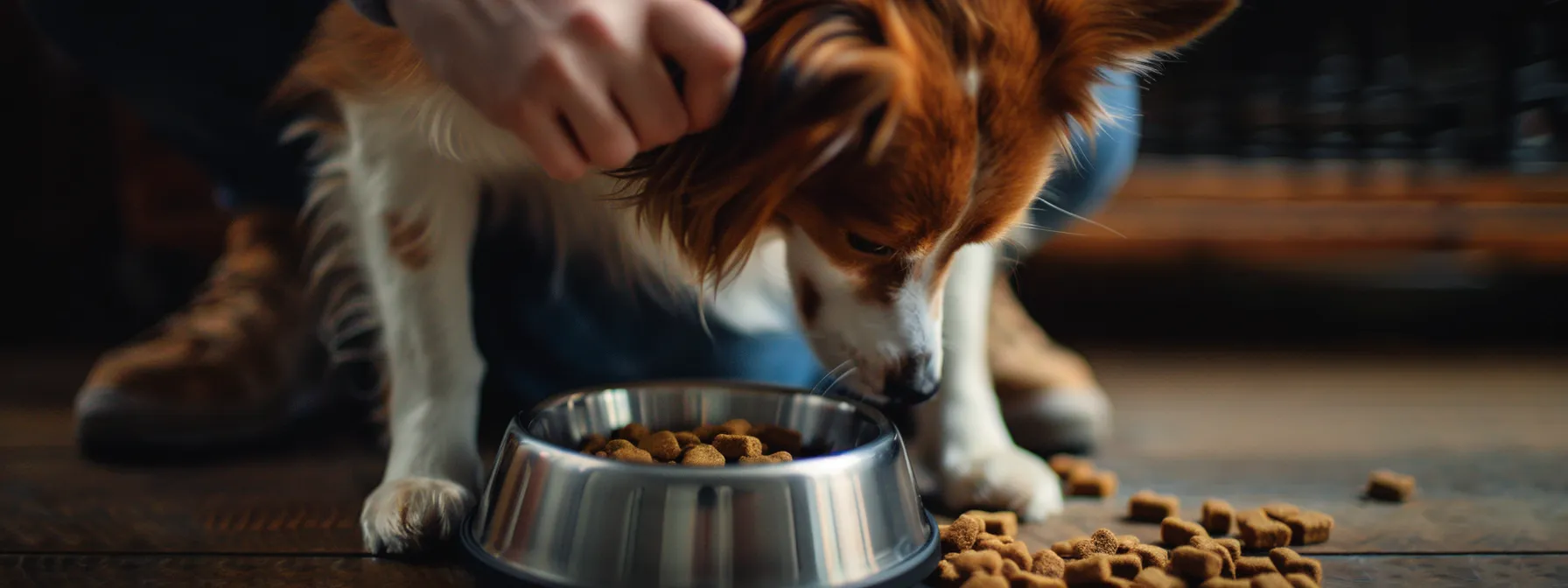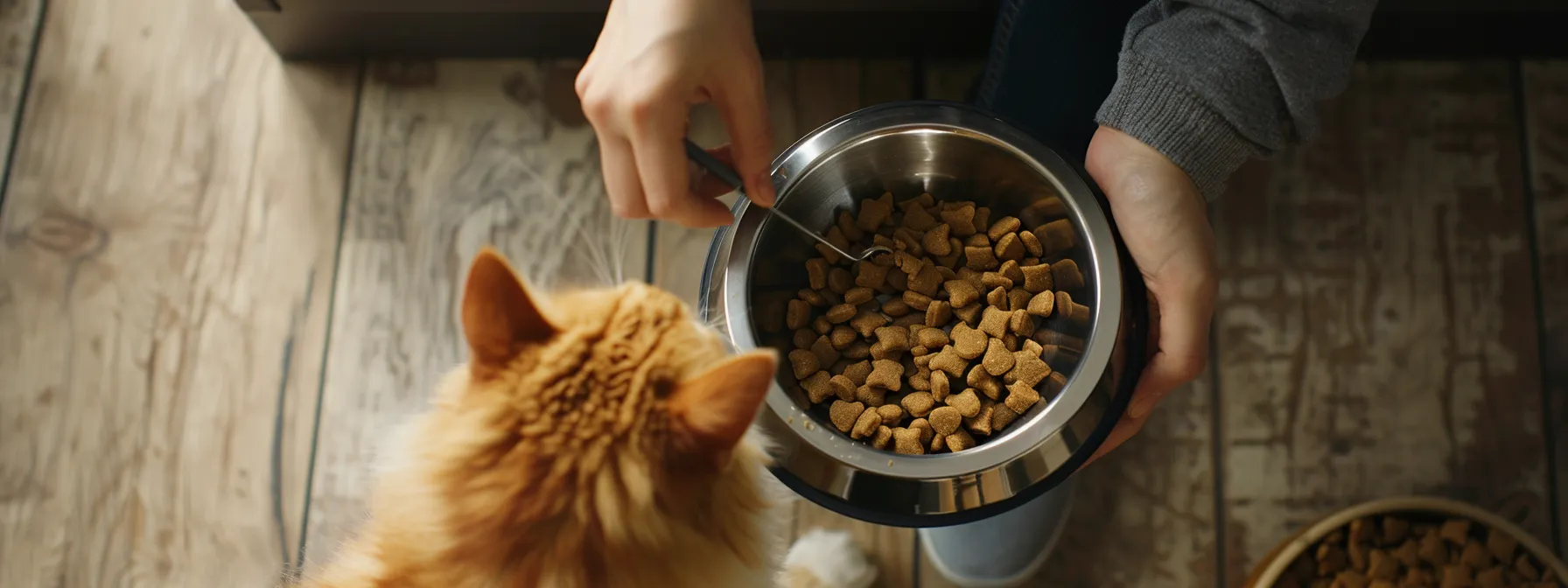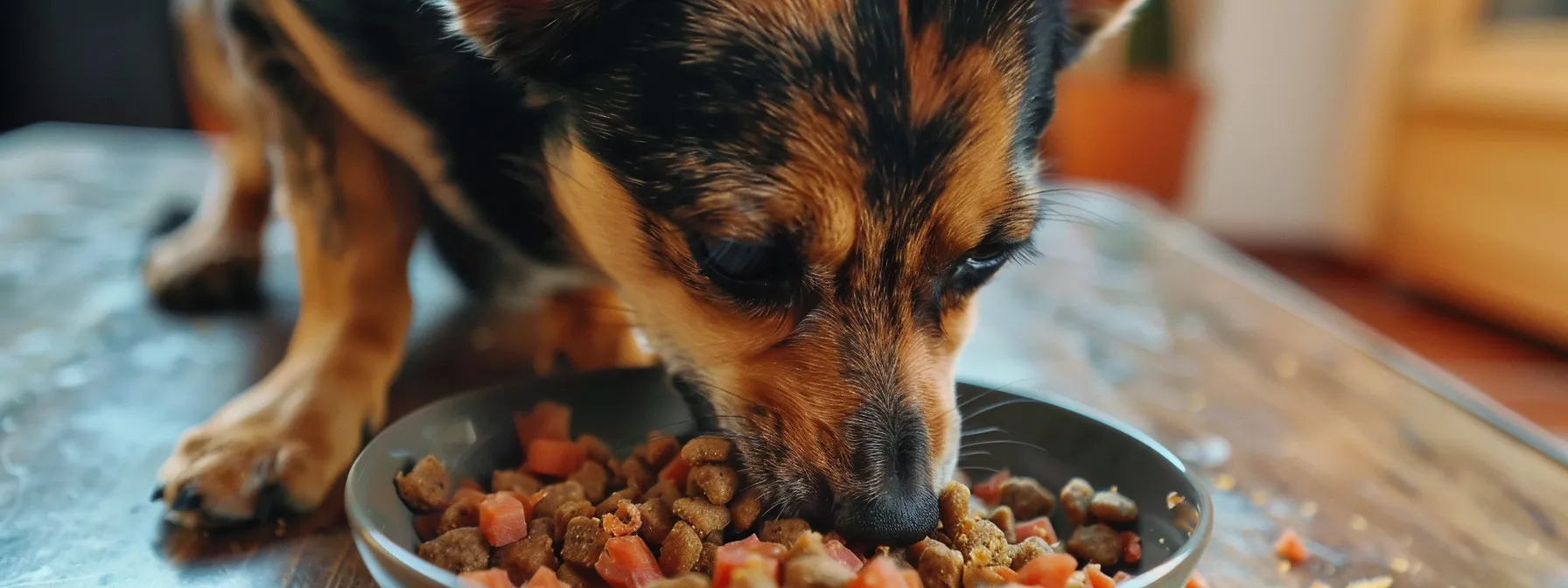Crafting a Perfect Pet Feeding Schedule: A Step-by-Step Guide
For pet owners seeking to imbue their animal companions’ lives with organic wellness tips, a meticulously crafted feeding schedule is pivotal. It’s akin to humans searching for the best vegan restaurants in NYC to maintain their weight and health through quality meals. The right feeding plan can help steer a pet towards optimal health and vitality, laying the groundwork for a lifestyle that’s both fulfilling and free from dietary concerns. In this article, readers will discover the fine art of balancing a pet‘s diet, ensuring their furry companions thrive at every stage of life.
Understanding the Fundamentals of a Pet Feeding Schedule

A pet feeding schedule establishes routine and structure for a pet‘s dietary regimen, affecting not only when but what they eat. This structured approach matters significantly as it aligns with a pet‘s nutritional requirements, which vary based on life stages, from a playful puppy to a sedentary senior. Considering a precise calorie count and the correct balance of nutrients is paramount when choosing pet food options. Moreover, by assessing a pet’s age and activity levels, pet owners can determine the appropriate portion sizes and frequency of meals to ensure their pets are receiving optimum nutrition and maintaining an ideal weight. One cannot overlook the significance of understanding the symbiotic relationship between a well-planned feeding schedule and the overall health and well-being a pet experiences through measured and consistent eating habits.
What Is a Pet Feeding Schedule and Why It Matters
A pet feeding schedule delineates the prearranged times and amounts for feeding a pet, emphasizing the crucial role organic wellness tips plays in their health. Such a plan helps regulate pet intake of dog food and other dietary components, ensuring that pets adhere to a diet befitting their specific health requirements and lifestyle. A reliable feeding routine also aids in preventing the onset of obesity, which is a rising concern among domestic animals, due largely to unregulated feeding and poor diet choices.
Adherence to a pet feeding schedule can significantly reduce the risk of various diseases associated with poor diet, such as diabetes or heart conditions. For a pet owner, establishing a structured feeding regime is a proactive step towards maintaining the pet‘s health and can serve as an effective tool in managing and monitoring their pet‘s nutrition over time. This attentiveness can lead to early detection of changes in appetite or weight that may indicate underlying health issues:
| Time of Day | Amount | Type of Food | Notes |
|---|---|---|---|
| Morning | 1 cup | Adult dog food | Monitor energy levels post-feeding |
| Midday | 1/2 cup | Weight management treats | Assess for signs of satiety |
| Evening | 1 cup | Senior dog food | Check for any changes in appetite |
Assessing Your Pet‘s Dietary Needs Based on Age and Activity
Calculating the proper nutrient intake for a pet requires consideration of its age, which influences metabolic rate and digestion, alongside the specific physical demands dictated by their lifestyle and behavior. Younger animals often need calorie-dense diets to support their growth and high energy requirements, whereas older pets benefit from tailored nutrition plans that promote maintaining a healthy weight and supporting slower metabolisms.
Furthermore, the unique physiological attributes of each dog breed can affect dietary needs; certain breeds may possess genetic predispositions that impact energy levels and digestion. Recognizing these breed-specific traits and behaviors is paramount in formulating a feeding schedule that ensures each pet receives the exact nutrients necessary for their individual health and vitality.
With the basics of pet feeding schedules in place, the next vital step is measurement. Let’s pinpoint exactly how much your companion needs to thrive.
Determining the Right Amount of Food for Your Pet

Establishing the correct quantity of food to place in your pet‘s bowl hinges on the meticulous calculation of their daily caloric needs, essential to maintaining optimal health. For pet owners, grasping the intricacies of a diet that aligns with their animal‘s unique physiological demands is as critical as recognizing potential human food allergies in pets. Adjusting meal portions plays a pivotal role in weight management, directly influencing the frequency of feedings required to ensure your pet remains within a healthy weight range. This careful consideration allows pet owners to provide a tailored diet that mitigates nutritional excesses or deficits, fostering a robust and energetic companion.
Calculating Daily Caloric Needs for Optimal Health
Calculating the daily caloric needs of a pet is a precise science that requires a clear understanding of their individual lifestyle and health profile. Knowing the specific caloric requirements enables pet owners to determine how much energy their animals require, which informs decisions about appropriate organic wellness tips dog foods and treats to include in their daily feeding.
For those pets with conditions such as diabetes, the stakes are even higher, as their dietary needs must be tightly managed to maintain their blood glucose levels. Accurate feeding regimens tailored to such health considerations are not merely beneficial, they are imperative to support the wellbeing and longevity of these animals.
Adjusting Portions for Weight Management
Modifying food portions is vital for averting excessive weight gain or loss in pets, requiring owners to be vigilant in measuring each feed. An oversized serving can lead to bloating, while food scarcity might condition a pet‘s stomach to endure unnecessary hunger, leading to distress and poor health organic wellness tips.
Establishing a routine that outlines the exact amount of calories a pet requires encourages a healthy eating habit, effectively satisfying their nutritional needs and averting the dangers of over or underfeeding. It’s a balancing act that maintains the stomach‘s integrity and regulates hunger without compromising on the pet’s health.
Understanding the right portion sizes for your pet sets the stage for a healthier lifestyle. Let’s move on to establishing a regular feeding schedule that further supports their well-being.
Setting Up a Consistent Feeding Routine

Creating a robust feeding schedule for pets entails more than merely filling a bowl; it involves careful consideration of optimal feeding times that align with the pet‘s breed-specific metabolic processes and daily routines. Veterinary medicine underscores the role of consistent feeding times in reinforcing stable metabolic rates, ensuring that pets, with their unique patterns of appetite and exercise, receive the nutrition they need at intervals conducive to maximal digestion and energy utilization organic wellness tips. Synchronizing meals with a pet’s natural rhythms optimizes their metabolism and supports overall health, setting the stage for both physical and psychological well-being.
Choosing the Best Times for Feeding
Pinpointing the optimal window for providing organic wellness tips nutrition involves a blend of assessing a pet‘s lifestyle, skin health, and domestic situation, such as mealtime in the kitchen. Coordinating feeding times with both the household’s schedule and the pet‘s circadian rhythms can lead to improved nutrient absorption and skin condition, reflecting overall health.
For pets on a weight loss journey, the timing of meals can be as significant as the content of their bowl, with carefully scheduled feedings that help regulate metabolism and encourage the burning of fat organic wellness tips. Aligning feed times with periods of activity aids in this process, ensuring pets receive the right energy at the right times for maximum benefit.
The Benefits of Consistency in Feeding Times
A steadfast adherence to feeding times reaps dividends in the prevention of malnutrition and overfeeding, leading to healthier weight profiles. By ensuring each meal is served at the same hour daily, a pet learns to anticipate feeding organic wellness tips, reducing the risk of anxiety-driven overeating, which can lead to being overweight.
With the meticulous introduction of each organic wellness tips ingredient at a scheduled time, the consistency serves a dual role: it establishes an effective weight management protocol and supports the pet‘s bodily need for timely protein absorption. This reliability aids in circumventing the adverse effects of irregular feeding practices, including sporadic hunger and malnutrition.
| Ingredient | Serving Size | Meal Time | Purpose |
|---|---|---|---|
| Protein-rich kibble | 1 cup | 7:00 AM | Morning energy provision |
| Weight management formula | 1/2 cup | 12:00 PM | Midday sustainment |
| Fiber-enhanced treat | Small portion | 5:00 PM | Digestive health |
Establishing a regular feeding schedule lays the foundation for your pet’s dietary health organic wellness tips. Now, discover the optimal balance of wet and dry best vegan restaurants in NYC foods to further optimize your furry companion’s nutrition.
Balancing Wet and Dry Food in the Diet

Discerning the ideal composition of a pet‘s diet involves scrutinizing the advantages of wet and dry varieties of food—each boasting unique benefits to a pet‘s health and overall well-being. A diet that includes both wet and dry components can yield nutritional completeness, harnessing the moisture content of wet food to support hydration and the crunchy texture of dry food to aid in dental health. When combined thoughtfully, these food types can also contribute to weight management, an essential consideration for pets recovering from neutering, as their caloric needs often decrease post-surgery. Understanding how to merge these food forms properly not only reinforces obedience and happiness through enjoyable meal experiences but also mitigates the risk of hypoglycemia, especially in smaller breeds prone to this condition. With such an approach, pet owners can complement dog training routines with timely rewards and ensure cat food contributes to a balanced diet. Tips for blending wet and dry food will provide guardians with a strategic method for maximizing the nutritional and hedonic value of their pets’ meals.
Understanding the Benefits of Both Food Types
Integrating both wet and dry food into a pet’s regimen offers distinct advantages, particularly for those that might be underweight and in need of more substantial meals. Wet food, with its higher moisture content, can facilitate easier digestion and soothe animals who have recently endured surgery, reducing potential abdominal pain associated with recovery.
Meanwhile, dry food encourages pets to indulge in grazing behavior, a natural eating pattern that can reduce the risk of rapid eating and subsequent abdominal pain. The crunchy texture also aids in maintaining dental health, which can alleviate the discomfort of dental-related pain and support overall wellness.
Tips for Mixing Wet and Dry Foods
When integrating fish-based wet foods – rich in omega-3 fatty acids – with dry alternatives, pet owners should attend to the dietary impact this has on their pet‘s energy levels and dog behavior. The combination should offer a balanced nutritional profile without over-reliance on sugar-laden foods that may lead to health issues.
Incorporating a scheduled snack that combines dry food with a moist, palatable topping can encourage pets to consume their meals in full, supporting a healthy feeding regimen. Pet owners should consider using a cart-based organizational system to store and manage both wet and dry food, ensuring freshness and ease of access during meal preparation.
As pets age, their nutritional needs evolve. Discover how adjusting their feeding schedule can support their health through the golden years.
Adjusting the Feeding Schedule as Your Pet Ages

As pets progress through different stages of life, their dietary needs evolve, necessitating modifications to their feeding schedules. Young animals such as puppies and kittens thrive on diets formulated to fuel rapid growth and development, yet their immature digestive systems can be sensitive, sometimes resulting in diarrhea if not fed appropriately. Anxiety around feeding times, commonly observed in pets of all ages, can be mitigated by providing consistent meal routines. Pet owners frequently seek faq resources for guidance on smoothly transitioning their growing pets to adult diets, minimizing issues such as upset stomach or cough that could stem from dietary changes. For kittens transitioning to adult cat food, the process must be gradual to avoid gastrointestinal distress and to ease them into a new nutritional phase. This section of the guide will offer insights on tailoring a pet feeding schedule that accounts for these special considerations, supporting pet owners in nurturing their companions from playful youth through to their golden senior years.
Special Considerations for Puppies and Kittens
Diligent attention to dietary needs is particularly critical for puppies and kittens, with a primary focus being on a thorough physical examination to tailor their nourishment properly. Early detection and prevention of serious health issues, such as cancer, depend on a well-considered diet that includes high-quality proteins like chicken, ensuring robust dog health and development during these formative months.
In the digital age where terms like “javascript” seem ubiquitous, the programming of a pet‘s health is no less complex and requires precise guidelines and adjustments. For growing pets, owners must routinely evaluate their feeding schedules in conjunction with regular veterinary visits to ensure all dietary needs are met for sustaining a strong immune system and preventing chronic conditions.
Transitioning to Adult and Senior Pet Diets
As a pet matures, the guidance of a Doctor of Veterinary Medicine (DVM) is invaluable when adjusting the diet from high-energy puppy food to formulas with calibrated nutritional content suitable for adults. The change not only alters the composition of the meals but also the feeding schedule, ensuring it supports the dog’s slower metabolic rate as it ages.
Incorporating the advice of a DVM becomes even more critical when a mature dog eats their way into the senior years. This transition brings a need for dietary adjustments that address age-related health issues, further refining the nutritional schedule to maintain a pet‘s health and vitality.
As pets grow older, their dietary needs inevitably change. Vigilant monitoring and timely adjustments to their feeding schedule can ensure optimal health through their golden years.
Monitoring and Adapting the Feeding Schedule

Continuous evaluation and modification lie at the heart of a successful pet feeding regimen. For owners intent on optimizing dog feeding practices, maintaining a detailed feeding log provides invaluable insights into their pet’s dietary response, allowing for fine-tuning of meal portions and frequencies. Through vigilant observation of health indicators, such as dental condition and weight, pet parents can ensure the upkeep of a pet‘s robust health. Moreover, navigating the global landscape of pet nutrition can pose challenges which may necessitate professional intervention. Should deviations in a pet‘s health become evident, or should the pet’s needs evolve, consulting with a veterinarian for dietary adjustments becomes imperative. This ongoing assessment ensures that the pet thrives on a diet adapted to their changing needs.
Keeping a Feeding Log and Observing Your Pet‘s Health
Accurate record-keeping through a feeding log is an essential tool for pet owners striving to maintain optimal health for their animals. Tracking the quantities of dog treats, regular meals, and their timings empowers owners to identify patterns and intercept potential issues before they escalate. A well-maintained log becomes a historical record, guiding adjustments in feeding practices in response to a pet‘s changing nutritional needs.
Employing a chart system enhances the precision of mealtime management, enabling pet owners to monitor their pet‘s intake and behavior with ease. This systematic approach aids in fostering a stable routine, which is instrumental in avoiding overfeeding or undernourishment and detecting any irregularities that could signal underlying health concerns.
| Date | Mealtime | Food Type | Amount Given | Observations |
|---|---|---|---|---|
| April 1 | 8:00 AM | Puppy kibble | 1 cup | High energy post-meal |
| April 1 | 3:00 PM | Dog treats | 3 pieces | No issues; consumed eagerly |
| April 1 | 6:00 PM | Adult dog food | 1 cup | Sluggish after meal; portion size? |
| April 2 | 8:00 AM | Puppy kibble | 1 cup | Normal activity; good appetite |
When to Consult a Vet for Dietary Adjustments
Seeking the expertise of a veterinarian is advisable when pet owners notice abnormalities in their pet’s response to diet, such as adverse reactions to specific foods like cheese, or difficulties with weaning young animals onto solid foods. A professional’s insight ensures that these dietary changes won’t negatively affect the pet’s well-being, especially when transitioning to new stages of dietary requirements.
Moreover, if signs of health issues such as unexplained changes in weight, lethargy, or abnormalities in blood metrics arise, consulting a vet is imperative. Veterinary guidance can be the difference between a simple adjustment to the feeding schedule and overlooking a condition requiring medical intervention. The vet may recommend tests or include certain foods in a pet‘s diet, just as one might add items to a shopping cart with care and consideration for maintaining balance and health.
| Date | Observation | Veterinarian Recommendations | Adjustments Made |
|---|---|---|---|
| May 15 | Refusal to eat cheese-based treats | Test for allergies | Removed cheese from diet |
| June 01 | Difficulty in weaning to solid food | Gradual introduction to different textures | Incorporated a mix of wet and dry food |
| June 20 | Weight loss and low energy | Complete blood workup | Adjusted diet based on blood analysis |
| July 04 | Initial vet consultation | Propose balanced diet, monitor health | Implemented a structured feeding regime |
Frequently Asked Questions
What constitutes a healthy pet feeding schedule?
A healthy pet feeding schedule hinges on regular, portion-controlled meals tailored to the species, age, health, and activity level of the animal. Consistency in meal times and attentive observation of the pet‘s appetite and weight are also key components to maintaining their well-being.
How do I determine the correct food quantity for my pet?
Determining the right amount of food for a pet depends on various factors, including the animal‘s age, weight, activity level, and the calorie content of the food. To ensure precise feeding, consulting a veterinarian and adhering to the feeding guidelines provided by the pet food manufacturer are recommended steps.
For specific measurements, one may implement the following guidelines:
- Review the pet food packaging for initial serving suggestions based on pet size and weight.
- Adjust portions according to the pet’s daily exercise and energy expenditure.
- Monitor the pet’s body condition and weight, adjusting the food quantity, under a vet’s guidance, to maintain optimal health.
- Consider the pet‘s life stage—puppies and kittens, for instance, often require more food than adult pets due to their growth needs.
Regular weight check-ups and dietary adjustments will help maintain the pet‘s health over time.
Why is consistency important in pet feeding routines?
Consistency in pet feeding routines establishes predictability and stability in an animal‘s day, which can significantly reduce stress and anxiety. It also helps to manage dietary health and maintain regular bodily functions.
A regular feeding schedule assists pet owners in monitoring their pet‘s appetite and quickly identifying any changes that may indicate health concerns. As pets thrive on routine, consistent feeding times aid in reinforcing good behavior, supporting training efforts, and strengthening the bond between pets and their owners.
Maintaining a consistent routine is especially beneficial for managing weight and digestive health in pets. Irregular feeding can lead to overeating, obesity, or gastrointestinal issues as animals struggle to adapt to an unpredictable eating schedule. By feeding pets at the same times daily, owners are better equipped to control portions and ensure their pets receive the correct amount of nutrition.
In summary, a consistent pet feeding routine is a cornerstone of responsible pet care. It upholds a structure that supports an animal’s emotional well-being, facilitates effective training, and promotes optimal physical health.
Can I mix wet and dry food in my pet‘s idet?
Yes, blending wet and dry food is acceptable for most pets. It’s advisable to consult with your veterinarian to ensure it meets your pet‘s specific dietary requirements.
How should a pet‘s feeding plan change with age?
As pets age, their dietary needs shift due to changes in metabolism, activity level, and health concerns; hence, their feeding plan must also evolve. This transition often involves adjusting calorie intake, incorporating different nutrient proportions, and potentially introducing specialized foods designed for senior animals.
Conclusion
Crafting an ideal pet feeding schedule helps manage portion sizes and meal frequency, crucial for a pet‘s optimal health and weight control. By factoring in age, activity levels, and specific health needs, owners can customize their pet‘s diet to enhance overall well-being. Consistent feeding times synchronized with a pet‘s natural rhythms support efficient metabolism and prevent dietary-related disorders. Regular monitoring and adjustments with professional veterinary advice ensure the feeding regimen evolves alongside the pet’s life stages, maintaining their health and vitality.






